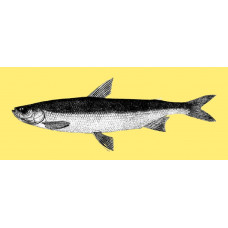Latin name
Coregonus sardinella
Other name
Sardine cisco, Siberian cisco.
Identification
The body of the Least Cisco is elongated, somewhat compressed at the sides, with the greatest depth of the body in front of the dorsal fin. The head is approximately 19-24% of the total length. The eyes are large. The length of the snout is usually less than the diameter of the eye. The mouth is moderate, terminal, the lower jaw is always prominent, the upper jaw is at a distinct angle, extending posteriorly below the anterior half of the eye. The tongue has a small number of teeth.
Features of fish fins
Dorsal spines (total): 0; Dorsal soft rays (total): 12 - 14; Anal spines: 0; Anal soft rays: 10 - 13.
Fish colouring
The overall coloration of the Least Cisco is silvery, usually brown to dark green on the back, becoming silvery on the sides and underneath. The smaller non-passerine form, which persists in freshwater, is unspotted on the back, and only the pelvic fins have black pigmentation at the tips. The rest of the fins are unpigmented. The larger passerine form has dark spots on the head, back, dorsal and adipose fins, and sometimes on the pectoral fins. The tips of all fins are usually dark.
Distribution
This species is found throughout the Arctic Ocean basin, from the White Sea to Alaska.
Habitat
Polar marine and freshwater brackish pelagic-neritic anadromous species. Adults inhabit coastal waters, estuaries, large lakes and rivers.
Size
Size Least cisco up to 35 cm (maximum), maximum mass not more than 1 kg. Life expectancy is 12-15 years. It is noted that migratory forms live longer than freshwater forms.
Behavior
Typical catadromous fish. Tolerates considerable salinity and enters the river to reproduce. Lake-dwelling populations do not appear to migrate, while those in streams or brackish water travel considerable distances to reach or leave spawning grounds.
Food and feeding habits
Catadromous populations forage in estuaries, lower reaches of rivers, backwaters and lakes. They feed on planktonic crustaceans and insects as well as plants and fish.
Reproduction
Becomes sexually mature in the 6th year of life at a weight of 200 grams. Breeds in the fall. Spawns in deep water on sand and gravel.
Fishing
Despite the small size of this species, it is considered a staple of the fishery.
Relationship with a person
Harmless. Eaten as food, the meat is considered delicious.
| Classification | |
| Phylum | Chordata |
| Class | Actinopterygii |
| Squad | Salmoniformes |
| Family | Salmonidae |
| Genus | Coregonus |
| Species | C. sardinella |
| Features | |
| Conservation status | Least Concern |
| Habitat | Pelagic |
| Life span, years | No information |
| Maximum body weight, kg | 1 |
| Maximum length, cm | 35 |
| Sailing speed, m/s | No information |
| Threat to people | Edible |
| Way of eating | Planktonophage |
Least cisco
Tags: least cisco

